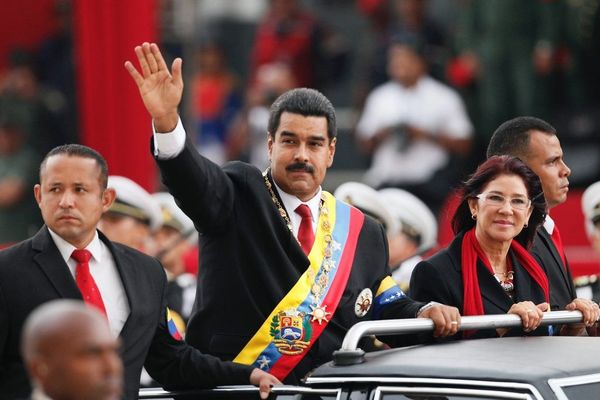Recent efforts by Pakistani Prime Minister Nawaz Sharif and Indian Prime Minister Narendra Modi have resurrected the idea of rapprochement between India and Pakistan. So successful were these efforts that Pakistani militants felt compelled to stage an attack on an airbase in Indian Punjab early last month to derail them. From the perspective of U.S. policymakers—both in the administration looking to make the most of its final year in power, and among the presidential hopefuls looking to score political points—it will be tempting to prescribe actions that the United States should take in the region.
Here are three points of reference for the United States to focus on as it develops its policies towards South Asia, with an eye towards supporting India-Pakistan rapprochement.
1. The United States should keep a low public profile on India-Pakistan matters.
Asian economic ambitions combined with the spread of Arab conflicts beyond the Middle East and the transformation of jihadist networks means that foreign governments and groups will become more involved in South Asia. As Saudi Arabia asserts itself more forcefully in the Middle East, it will continue to turn to Pakistan, whether it be for support in its fight in Yemen or consultation on sectarian strife. Iran will similarly look to cultivate relationships with India, Pakistan, and Afghanistan as international sanctions are lifted. The launch of the China-Pakistan Economic Corridor (CPEC) also means a greater consideration of Chinese interests in the region and greater India-Pakistan competition for this investment.
It will be tempting for the United States to want to follow suit. Doing more on India and Pakistan typically falls at the top of the list of any new administration’s goals of broader regional engagement in South Asia. But the reality is that the United States, for its part, will continue to be consumed by Afghanistan. While maintaining a significant troop presence, U.S. priorities will focus on Taliban reconciliation, supporting political stability, and tackling the evolution of jihadist groups, including the growth of ISIS affiliates. This is enough homework for one country.
But keeping a low profile is easier said than done. The U.S. role in the region is complicated by decades of security policy that has bound it into a policy paradox. Since the days of the Cold War, the United States has provided military aid to the Pakistani military, specifically for its assistance in fighting the Soviets in Afghanistan during the 1980s and then for its collaboration in targeting the Taliban and al Qaeda after 9/11. Beefing up the Pakistani military directly conflicts with Indian national security interests, which are premised on the view that it is Pakistan’s military that is the source of the country’s instability and terrorism problem. Moreover, U.S.-Pakistan relations have continuously been strained over Afghanistan, even as the two countries must work together on reconciliation and other defense cooperation issues. And to top it off, in the midst of such contradictions, the United States and India continue to build a strategic partnership based on mutual interests.
While the United States may feel compelled to play the role of a global leader, to India and Pakistan, the American policies are more in line with another local faction struggling for its own interests, rather than the outside actor it intends to be. Because of this, keeping a low public profile on India-Pakistan matters is the best approach and most helpful to the two countries.
2. The United States should turn Punjab into a Pakistan issue – not an India issue.
Whenever the issue of Punjabi militants is raised in Washington, it is in the context of a cross-border attack on India by Pakistani militants Yet, it’s time for the United States to focus more on Punjab – and not just because of India and the latest incident in Pathankot. There is good news in that Pakistan’s military is focused on fighting militants in FATA. Unfortunately, the FATA fight is keeping it from dealing directly with the militants in Punjab, an equally lethal but perhaps more ideologically motivated bunch. The United States has also focused heavily on the FATA militants because of their impact on Afghanistan, but it is time to broaden that perspective.
Punjab is important to Pakistan for many reasons. It is the economic center of the country and the most populous province. Punjabi elites are influential throughout the political establishment and the military. Adjacent to Kashmir and the Indian border, Punjab will always have the fore in Pakistan’s national security policy. It is also the heart of Pakistani militancy. Yet, Pakistan’s history of taking on these groups is mixed and weak. Fears of backlash, toothless anti-terrorism legislation, and a corrupt and frail judiciary make it difficult to prosecute militant leaders and dismantle extremist organizations.
But new developments there foreshadow both trouble and opportunity. The public conversation in Pakistan on terrorism has visibly shifted since the December 2014 attack on a school in Peshawar. There is heightened ownership of the internal threat and growing willingness to speak out against these militants. Increased public support has pushed the military to respond at least in FATA. Observers in Pakistan have noted that until the Pathankot attack, militant groups have been relatively quiet, and there have been fewer militant rallies. There is also concern over the presence of ISIS-affiliated foreign fighters, who the authorities are trying to eliminate. What is less visible is the internal conversation on how Pakistan deals with militant groups. The military likely does not want to confront these groups head on, but there is visibly less space for them writ large on account of the national conversation – and thus, privately, forcing a dialogue on what to do about them.
It would be naïve to suggest the military’s approach to these groups has changed simply because of less militant activity. But in a country where the use of militants as proxies has shaped the foundation of national security policy since its inception, a gradual, understated, and microcosmic shift occurring in reaction to unfortunate events and public pressure is a milestone. Yet this momentum will be for naught if Punjabi militancy continues to be overshadowed by the fight in FATA or is reduced to being a problem of attacks against India.
3. The United States should continue to use private diplomacy to foster greater dialogue between India and Pakistan.
The United States keeping a low profile in South Asia will mean using private diplomacy more – an area where the Americans could be more helpful in supporting a long-term rapprochement between India and Pakistan. The United States can’t prevent cross-border terrorism, nor can it control the harmful rhetoric in both countries that ties the hands of politicians from resuming dialogue. But the U.S. has been responsive and successful in the past during moments of crises. For example, during the 1999 Kargil conflict, President Bill Clinton defused a nuclear escalation between India and Pakistan when he intervened after the Pakistani government infiltrated the Kargil region of Kashmir.
At the same time, responding to the crisis du jour need not be the role of the United States. The time has come for an approach that is more focused on building the foundations for dialogue and convening stakeholders, and less about immediate conflict resolution. One of the angles the late Ambassador Richard Holbrooke pursued tirelessly during his tenure as Special Representative for Afghanistan and Pakistan, was to bring Indian, Pakistani, American, and Afghan leaders into continuous talks– bilateral, trilateral, quadrilateral, multilateral – on the most difficult of subjects, from Taliban reconciliation to border security. As uncomfortable as those meetings were, his efforts to do so brought to light the desperate need of South Asian leaders for face time with one another and opportunities to engage on the most difficult of subjects. If done with subtlety and discretion, the United States is perfectly poised to play an influential convening role, despite the paradoxical nature of its security policies in South Asia.
Like their South Asian counterparts, American policymakers should build a more complementary approach to India-Pakistan rapprochement. U.S. policies on India and Pakistan have frequently been at odds with each other, creating a perception that American approaches to one country over the other are part of a zero-sum game. A united policy that represents Indian and Pakistani positions would begin to alleviate the contradictions in the American approach. Furthermore, the continuation of regular visits between Kabul, Islamabad, and Delhi by their respective U.S. ambassadors would also encourage more connected and practical thinking on the issues affecting regional stability writ large.
History tells us that the United States can be constructive in India-Pakistan relations when it is needed most. A more constructive and long-term policy approach based on prioritizing American engagements in South Asia, approaching Pakistan’s militant problem through the lens of Pakistan’s own internal stability, and utilizing private diplomacy would bring us closer to a South Asia that does not periodically devolve to the brink of nuclear war and back.














